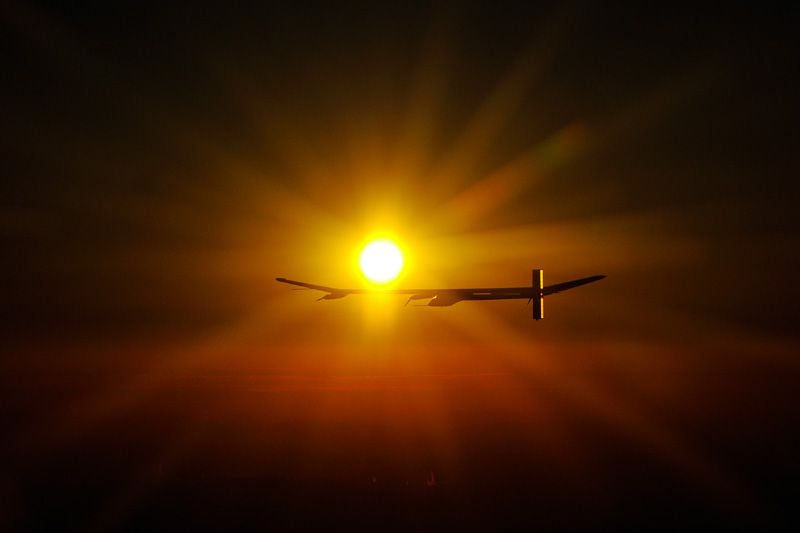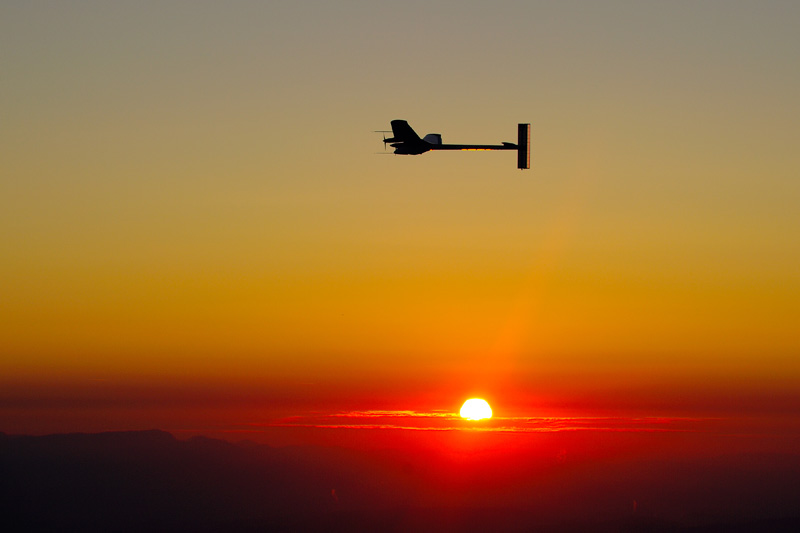8 July 2010: Borschberg Breaks the First Solar-Powered Aeroplane Records Onboard Solar Impulse

Five years ago today, Swiss pilot André Borschberg landed the zero-fuel aircraft Solar Impulse HB-SIA after a 26h 10m 19s flight from and to Payerne, Switzerland. A normal duration for a jet, but an absolutely incredible performance for a plane using only the power of the sun!
So much so that it established the first records in the Solar-Powered Aeroplane Category, not only in Duration, but also in Absolute Altitude (9235m) and Gain of height (8744m).
Since then the Solar Impulse project has considerably flourished. More milestones were reached and more records broken either by Bertrand Piccard, the initiator of the project (pictured above on the left), or by André Borschberg (right), the co-founder, including during the on-going Round-the-World Mission. A few days ago, Borschberg achieved the exploit to cross the Pacific Ocean from Japan to Hawaii, thus covering the staggering distance of 6449.8 km. This shows the amazing breakthroughs made in solar energy since the start of the project!
All of the Solar Impulse flights were followed by millions of people live on the Internet and commented on by the world’s most important media organisations. This global media impact has enabled Piccard’s message about how important new technologies are for reducing our society’s dependence on fossil energy to spread.
Through the night, with the energy stored up during the day
 At 6:51am on 7 July 2010, Solar Impulse took the air with Borschberg at the controls. For the whole day, the zero-fuel aircraft ascended at a slow pace until reaching the altitude of 9235m.
At 6:51am on 7 July 2010, Solar Impulse took the air with Borschberg at the controls. For the whole day, the zero-fuel aircraft ascended at a slow pace until reaching the altitude of 9235m.
At the same time, it recharged its batteries to be able to achieve the most difficult part of the challenge: to fly through the night using only the energy stored up during the day by its solar cells.
When the last rays of the sun began to fade about two hours before sunset, the solar cells could no longer recharge the batteries and the plane started its long descent. At 23:00, it was flying at around 1500m, an altitude that it maintained during the night.
Using the energy stored in the batteries, the pilot skilfully managed to keep his aircraft in the air until the next morning. At 9:00, Solar Impulse successfully landed back at the Payerne airport.
Borschberg said on leaving the cockpit: "I've been a pilot for 40 years now, but this flight has been the most incredible one of my flying career. Just sitting there and watching the battery charge level rise and rise thanks to the sun… And then that suspense, not knowing whether we were going to manage to stay up in the air the whole night. And finally the joy of seeing the sun rise and feeling the energy beginning to circulate in the solar panels again!”

A long term project
The idea of Solar Impulse was first born in Piccard’s mind after completing his round-the-world balloon flight with Brian Jones in 1999. He realised at that moment that his next challenge would be to accomplish the same exploit, but without fuel or pollution emissions.
Four years later, in 2003, after teaming up with engineer and fighter pilot Borschberg and getting a conclusive feasibility study, the Solar Impulse project was officially launched.
April 2010 saw the maiden flight of the prototype HB-SIA as a result of seven years of calculation, design, simulation and construction. In July of the same year, Borschberg’s overnight flight opened very positive prospects for the future.
Other successful flights took place, still with HB-SIA, such as the first intercontinental flight from Spain to Morocco in 2012, and those made during the Across America Mission in 2013.
In April 2014, Solar Impulse 2 (SI2) was unveiled to the public and made a series of test flights, until it was judged ready for its ultimate challenge: the circumnavigation of the Earth.
The Round-the-World Mission started on 9 March 2015 with a flight from Abu Dhabi (UAE) to Muscat (Oman). Ahmedabad (India), Varanasi (India), Mandalay (Myanmar), Chongqing (China), and Nanjing (China) followed, with either Borschberg or Piccard as pilot of the one-seater. The next leg should have brought SI2 directly to Hawaii but Borschberg rerouted the aircraft to Nagoya (Japan) due to worsening weather conditions. However Borschberg took-off again on 28 June from Nagoya and landed Hawaii after a fantastic flight that lasted 117 hours 52 min. The solar-powered aircraft will then continue its epic journey until reaching its starting point.
[[{"fid":"11567","view_mode":"wysiwyg_display","fields":{"format":"wysiwyg_display","field_folder[und]":"2"},"type":"media","attributes":{"class":"media-element file-wysiwyg-display"}}]]
